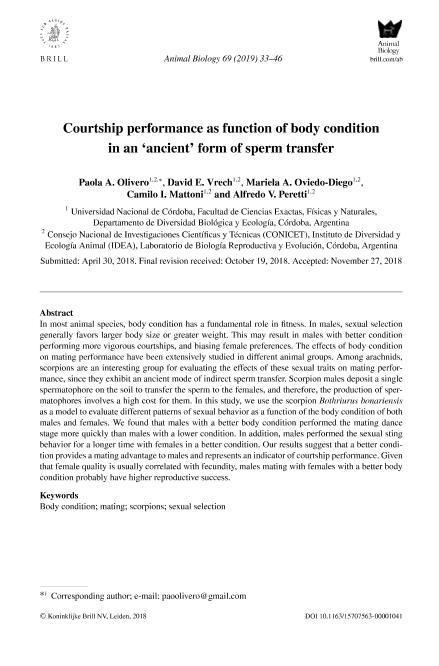Mostrar el registro sencillo del ítem
dc.contributor.author
Olivero, Paola Andrea

dc.contributor.author
Vrech, David Eduardo

dc.contributor.author
Oviedo Diego, Mariela Anahí

dc.contributor.author
Mattoni, Camilo Ivan

dc.contributor.author
Peretti, Alfredo Vicente

dc.date.available
2019-11-27T17:01:42Z
dc.date.issued
2018-11
dc.identifier.citation
Olivero, Paola Andrea; Vrech, David Eduardo; Oviedo Diego, Mariela Anahí; Mattoni, Camilo Ivan; Peretti, Alfredo Vicente; Courtship performance as function of body condition in an 'ancient' form of sperm transfer; Brill Academic Publishers; Animal Biology; 69; 1; 11-2018; 33-46
dc.identifier.issn
1570-7555
dc.identifier.uri
http://hdl.handle.net/11336/90656
dc.description.abstract
In most animal species, body condition has a fundamental role in fitness. In males, sexual selection generally favors larger body size or greater weight. This may result in males with better condition performing more vigorous courtships, and biasing female preferences. The effects of body condition on mating performance have been extensively studied in different animal groups. Among arachnids, scorpions are an interesting group for evaluating the effects of these sexual traits on mating performance, since they exhibit an ancient mode of indirect sperm transfer. Scorpion males deposit a single spermatophore on the soil to transfer the sperm to the females, and therefore, the production of spermatophores involves a high cost for them. In this study, we use the scorpion Bothriurus bonariensis as a model to evaluate different patterns of sexual behavior as a function of the body condition of both males and females. We found that males with a better body condition performed the mating dance stage more quickly than males with a lower condition. In addition, males performed the sexual sting behavior for a longer time with females in a better condition. Our results suggest that a better condition provides a mating advantage to males and represents an indicator of courtship performance. Given that female quality is usually correlated with fecundity, males mating with females with a better body condition probably have higher reproductive success.
dc.format
application/pdf
dc.language.iso
eng
dc.publisher
Brill Academic Publishers

dc.rights
info:eu-repo/semantics/openAccess
dc.rights.uri
https://creativecommons.org/licenses/by-nc-sa/2.5/ar/
dc.subject
BODY CONDITION
dc.subject
MATING
dc.subject
SCORPIONS
dc.subject
SEXUAL SELECTION
dc.subject.classification
Zoología, Ornitología, Entomología, Etología

dc.subject.classification
Ciencias Biológicas

dc.subject.classification
CIENCIAS NATURALES Y EXACTAS

dc.title
Courtship performance as function of body condition in an 'ancient' form of sperm transfer
dc.type
info:eu-repo/semantics/article
dc.type
info:ar-repo/semantics/artículo
dc.type
info:eu-repo/semantics/publishedVersion
dc.date.updated
2019-10-16T14:24:39Z
dc.identifier.eissn
1570-7563
dc.journal.volume
69
dc.journal.number
1
dc.journal.pagination
33-46
dc.journal.pais
Países Bajos

dc.journal.ciudad
Leiden
dc.description.fil
Fil: Olivero, Paola Andrea. Consejo Nacional de Investigaciones Científicas y Técnicas. Centro Científico Tecnológico Conicet - Córdoba. Instituto de Diversidad y Ecología Animal. Universidad Nacional de Córdoba. Facultad de Ciencias Exactas Físicas y Naturales. Instituto de Diversidad y Ecología Animal; Argentina
dc.description.fil
Fil: Vrech, David Eduardo. Consejo Nacional de Investigaciones Científicas y Técnicas. Centro Científico Tecnológico Conicet - Córdoba. Instituto de Diversidad y Ecología Animal. Universidad Nacional de Córdoba. Facultad de Ciencias Exactas Físicas y Naturales. Instituto de Diversidad y Ecología Animal; Argentina
dc.description.fil
Fil: Oviedo Diego, Mariela Anahí. Consejo Nacional de Investigaciones Científicas y Técnicas. Centro Científico Tecnológico Conicet - Córdoba. Instituto de Diversidad y Ecología Animal. Universidad Nacional de Córdoba. Facultad de Ciencias Exactas Físicas y Naturales. Instituto de Diversidad y Ecología Animal; Argentina
dc.description.fil
Fil: Mattoni, Camilo Ivan. Consejo Nacional de Investigaciones Científicas y Técnicas. Centro Científico Tecnológico Conicet - Córdoba. Instituto de Diversidad y Ecología Animal. Universidad Nacional de Córdoba. Facultad de Ciencias Exactas Físicas y Naturales. Instituto de Diversidad y Ecología Animal; Argentina
dc.description.fil
Fil: Peretti, Alfredo Vicente. Consejo Nacional de Investigaciones Científicas y Técnicas. Centro Científico Tecnológico Conicet - Córdoba. Instituto de Diversidad y Ecología Animal. Universidad Nacional de Córdoba. Facultad de Ciencias Exactas Físicas y Naturales. Instituto de Diversidad y Ecología Animal; Argentina
dc.journal.title
Animal Biology

dc.relation.alternativeid
info:eu-repo/semantics/altIdentifier/url/https://brill.com/view/journals/ab/69/1/article-p33_4.xml
dc.relation.alternativeid
info:eu-repo/semantics/altIdentifier/doi/http://dx.doi.org/10.1163/15707563-00001041
Archivos asociados
